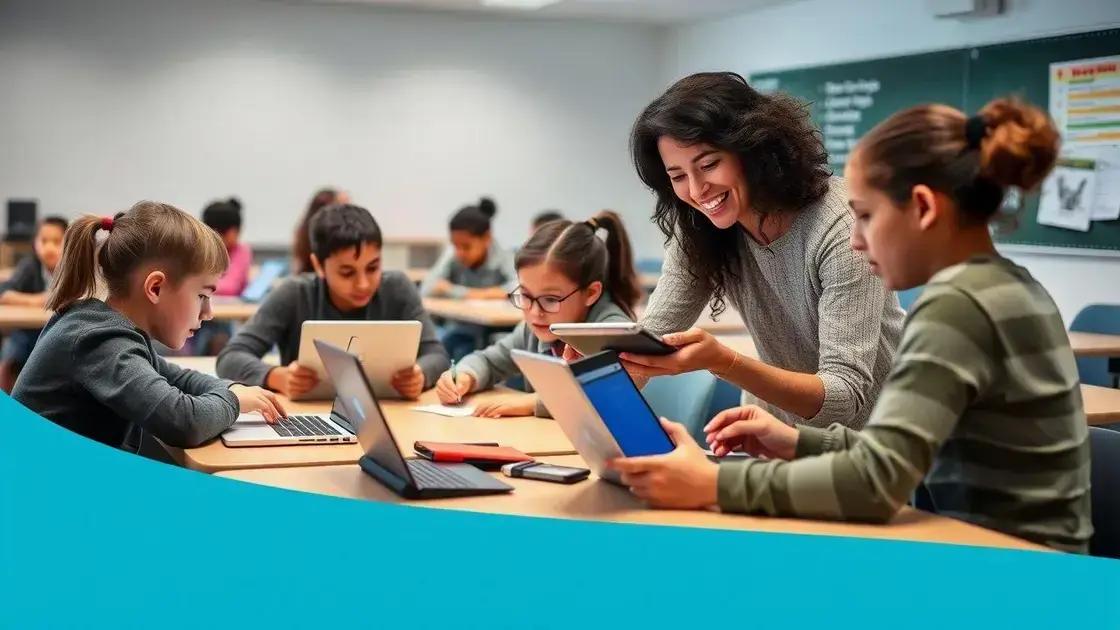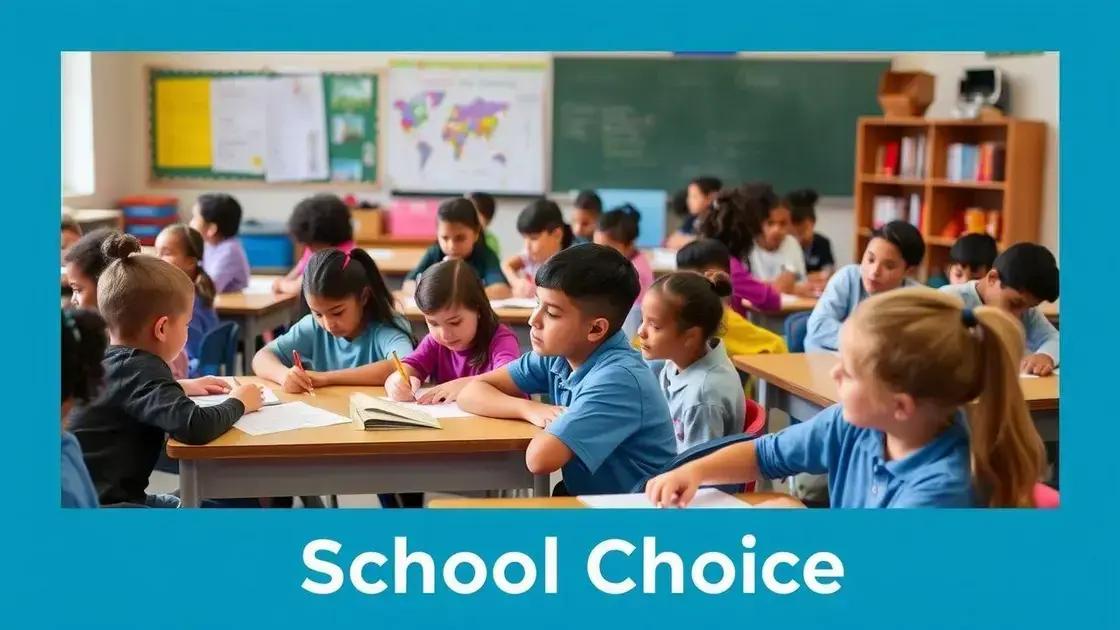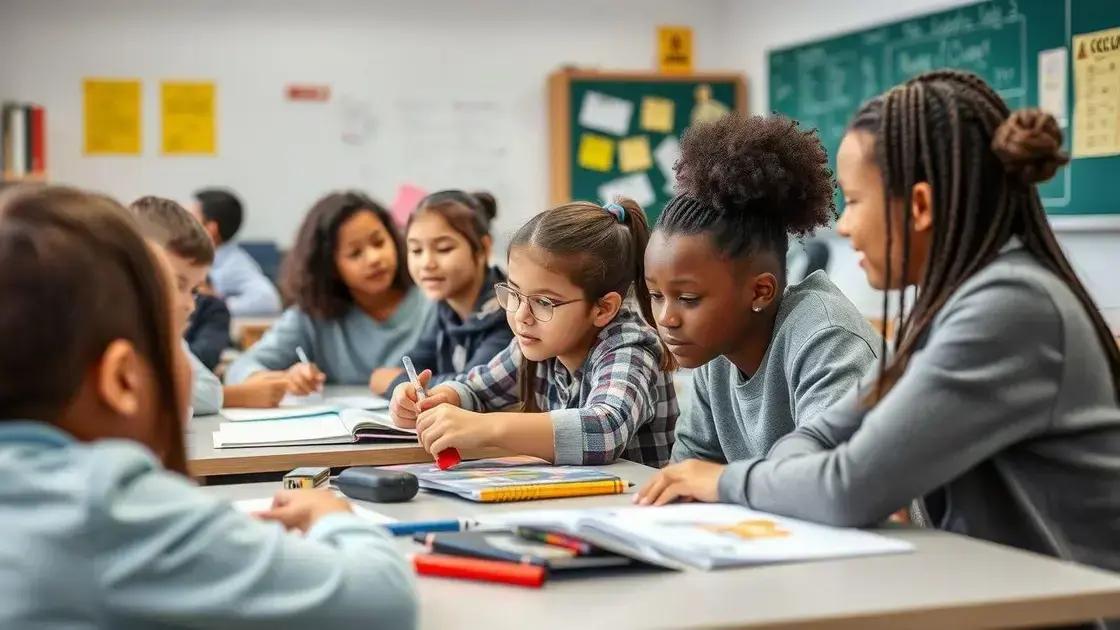Public school reform movements: what you need to know

Anúncios
Public school reform movements focus on enhancing education quality through personalized learning, integrating technology, promoting social-emotional development, and ensuring equity for all students.
Public school reform movements have become a pivotal part of discussions around education. You might wonder how these efforts affect your child’s learning experience and the community at large. Let’s dive into their significance and what they mean for the future.
Anúncios
Understanding public school reform movements
Understanding public school reform movements is essential to grasp how education evolves over time. These movements aim to enhance the quality of education and address systemic issues.
What Are Public School Reform Movements?
Public school reform movements focus on improving the education system. They include changes in curriculum, teaching methods, and school governance. The goal is to ensure that all students receive a quality education.
Anúncios
Common objectives of these movements include:
- Increasing student achievement
- Reducing educational disparities
- Enhancing teacher support and training
- Involving parents and communities
The History of Reform Movements
Historically, reform movements arose in response to various challenges in education. For instance, the 1960s saw a push for equal access to education for marginalized groups. This movement aimed at ending segregation and promoting equity.
Furthermore, the introduction of standardized testing in the late 20th century sparked debates about its effectiveness. Critics argued that it did not account for individual student needs.
The Role of Technology
Technology continues to play a significant role in modern public school reform movements. Online learning tools and resources have made education more accessible. Schools are now embracing digital platforms to enhance student engagement and collaboration.
- Interactive learning environments
- Access to online resources
- Development of digital literacy
These innovations are reshaping how students learn and how teachers deliver lessons, fostering a more inclusive educational experience.
Ultimately, by understanding public school reform movements, we gain insight into the ongoing changes in education. These reforms are crucial to creating a more effective and equitable system for all learners.
Key historical milestones in education reform
Key historical milestones in education reform have shaped the landscape of schooling as we know it today. These moments mark significant changes that aimed to improve educational accessibility and quality for all students.
The Common School Movement
In the 19th century, the Common School Movement emerged as a push for publicly funded education. This initiative helped lay the foundation for a system where all children, regardless of background, could attend school. It emphasized the importance of education as a public good.
The Brown v. Board of Education Case
A pivotal moment in the history of education reform came with the Brown v. Board of Education Supreme Court decision in 1954. This landmark ruling declared that segregated schools were inherently unequal and unconstitutional. As a result, it paved the way for desegregation in public schools.
- Abolishing racial segregation
- Promoting equal educational opportunities
- Transforming the approach to civil rights
The No Child Left Behind Act
In the early 2000s, the No Child Left Behind Act (NCLB) aimed to close achievement gaps by establishing accountability standards for schools. This legislation focused on standardized testing and required schools to meet specific performance benchmarks. While it had its benefits, NCLB also faced criticism for narrowing the curriculum.
- Standardized testing as a measure of success
- Increased federal involvement in education
- Focus on underperforming schools
As these key events illustrate, each milestone in education reform has contributed to shaping a more inclusive and equitable education system. Each step, while met with its challenges, has been crucial in addressing the evolving needs of students and communities.
The role of technology in reforming schools

The role of technology in reforming schools has become increasingly important in today’s educational landscape. By integrating technology into the classroom, schools can enhance the learning experience and provide students with the tools they need for success.
Enhancing Learning through Digital Tools
Digital tools have transformed traditional teaching methods. Students now have access to a wealth of information online, which encourages independent learning. For example, educational platforms and learning apps engage students in interactive ways.
- Access to online courses and resources
- Interactive simulations and virtual labs
- Collaboration tools for group projects
Supporting Teachers with Technology
Technology also supports teachers by providing them with resources for lesson planning and classroom management. Educational technology helps tailor lessons to meet diverse student needs, helping every child succeed.
Teachers can use data from assessments to track student progress. This ability allows them to adjust their teaching strategies in real time, making learning more personalized and effective.
The Importance of Digital Literacy
As technology continues to evolve, developing digital literacy in students is essential. This skill helps students navigate digital environments safely and effectively. Schools play a critical role in teaching not just how to use technology, but how to evaluate sources and communicate online appropriately.
Creating a community that values technology in education leads to a generation of skilled, informed individuals ready to face modern challenges. In this way, technology doesn’t just reform schools; it prepares students for future success.
Community involvement in public school changes
Community involvement in public school changes is crucial for creating a supportive and effective educational environment. When communities actively engage in the educational process, they help address the unique needs of their schools.
The Power of Local Partnerships
One significant aspect of community involvement is the establishment of local partnerships. Schools can work with businesses, non-profits, and local agencies to provide resources and programs that enhance student learning.
- Mentoring programs connecting students with professionals
- After-school activities sponsored by local organizations
- Fundraising events to support school initiatives
Parent and Guardian Engagement
Another vital element is the engagement of parents and guardians. When families are involved in their children’s education, students tend to perform better academically. Schools can encourage this involvement by hosting events that welcome parents into the school environment.
Activities such as parent-teacher conferences, workshops, and volunteering opportunities foster a sense of belonging and ownership in the school community. This participation can lead to important feedback and collaborative efforts to improve school policies.
Student-Led Initiatives
Empowering students to take action is also essential. Engaging students in advocacy and reform initiatives helps them develop leadership skills. When they feel heard, students are more likely to contribute positively to their environment.
Schools can support student-led initiatives by allowing them to create clubs, propose ideas for improvement, and participate in decision-making processes. This approach encourages a sense of responsibility among students and strengthens their commitment to school improvement.
Future trends in public education reform
Future trends in public education reform are evolving to meet the needs of today’s students and society. As we look ahead, several key themes are emerging that will shape the educational landscape.
Personalized Learning Approaches
One significant trend is the shift toward personalized learning. This approach tailors education to fit each student’s needs, interests, and learning pace. Technology plays a vital role in this transformation by providing adaptive learning platforms.
- Customized lesson plans based on individual strengths
- Real-time feedback to improve learning outcomes
- Flexible learning environments that promote choice
Integration of Social and Emotional Learning
Another trend gaining momentum is the integration of social and emotional learning (SEL) into the curriculum. Programs focused on SEL help students develop essential skills such as empathy, teamwork, and self-regulation. By addressing emotional well-being alongside academics, schools can create a more supportive learning environment.
Research shows that promoting SEL leads to improved academic performance, making it an essential part of education reform.
Increased Focus on Equity and Inclusion
The push for equity and inclusion continues to be a driving force in education reform. Schools are recognizing the importance of creating spaces where all students feel valued and represented. This shift encourages the development of curricula that reflect diverse perspectives and histories.
Efforts to remove barriers for underserved populations are crucial to ensuring that every student has access to quality education. Advocacy for equitable resources and policies will be at the forefront of future reforms.
As public school reform evolves, these trends will steer the future direction of education, making it more inclusive, adaptable, and supportive of every student’s unique journey.
As we look back on the significant progress made in public school reform, it’s clear that continued collaboration among educators, families, and communities is essential. With the trends of personalized learning, social and emotional development, and a focus on equity, the future of education looks promising. By embracing these changes, we can create an environment where every student thrives, ready to face the challenges of tomorrow.
FAQ – Questions About Public School Reform
What is the role of technology in education reform?
Technology enhances learning by providing personalized resources, facilitating communication, and engaging students in interactive activities.
How does community involvement impact public schools?
Community involvement strengthens public schools by fostering partnerships that provide resources and support for students and educators.
What are the trends in social and emotional learning?
Social and emotional learning focuses on developing students’ emotional intelligence, empathy, and interpersonal skills, which contribute to their overall well-being.
Why is equity important in education?
Equity ensures that all students have access to quality education and resources, regardless of their backgrounds, promoting a fair and inclusive learning environment.






